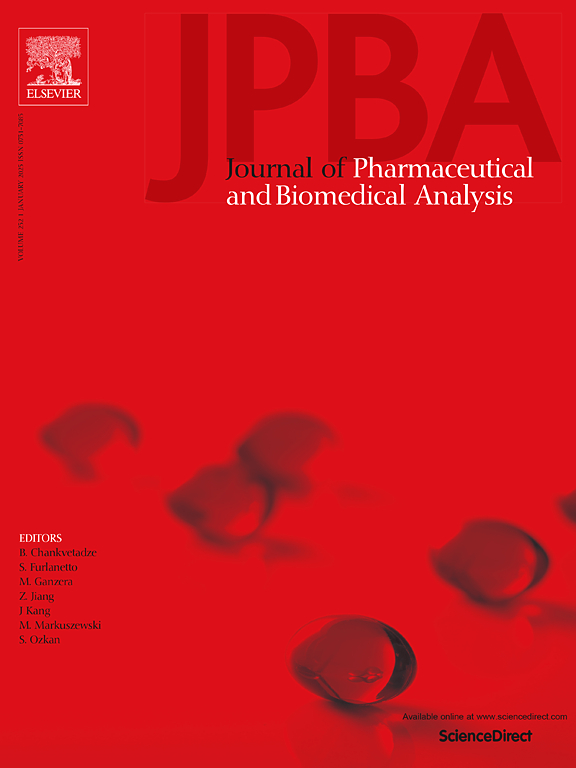Advancing UPLC-MS/MS for mapping the chemical fingerprint of bioactive compounds in lotus leaves (Folium Nelumbinis)
IF 3.1
3区 医学
Q2 CHEMISTRY, ANALYTICAL
Journal of pharmaceutical and biomedical analysis
Pub Date : 2025-03-26
DOI:10.1016/j.jpba.2025.116840
引用次数: 0
Abstract
Lotus (Nelumbo nucifera Gaertn.) is widely utilized in traditional medicine and cuisine throughout Asia, with its leaves containing valuable bioactive alkaloids and flavonoids. However, Lotus leaves are often considered as by-products, urging the need for methods to analyze these components and enhance biological and economic value. In this study, a novel, rapid, and reliable UPLC-MS/MS method was developed to evaluate the quality of Folium Nelumbinis by establishing the first chromatographic fingerprint of simultaneously determination of bioactive alkaloids (nuciferine, O-nornuciferine, N-nornuciferine) and flavonoids (kaempferol, quercetin, isoquercitrin, quercetin-3-O-glucuronide). The method was validated according to the Association of Official Analytical Chemists and European Commission Decision 2021/808/EC guidelines, demonstrating high sensitivity, specificity, and reproducibility, with detection and quantification limits below 0.48 ng/mL and 1.50 ng/mL, respectively. When the procedure was applied to 49 Lotus leaf samples collected across various regions and growth stages in Vietnam, revealing significant regional and developmental variations in alkaloid and flavonoid content. Nuciferine and quercetin-3-O-glucuronide were the most abundant compounds, with the highest alkaloid concentration found in Hanoi and the highest flavonoid content in Lam Dong. Besides, this study contributes not only to the quality control of Lotus leaves but also to the understanding of geographical and developmental impacts on their bioactive composition. The chromatographic fingerprinting initiative described here highlights the application of the approach as a potential standard for the quality and regularity of traditional herbal medicines and hence the sustainable and optimal utilization of Lotus leaves in pharmaceutical and nutraceutical applications.
求助全文
约1分钟内获得全文
求助全文
来源期刊
CiteScore
6.70
自引率
5.90%
发文量
588
审稿时长
37 days
期刊介绍:
This journal is an international medium directed towards the needs of academic, clinical, government and industrial analysis by publishing original research reports and critical reviews on pharmaceutical and biomedical analysis. It covers the interdisciplinary aspects of analysis in the pharmaceutical, biomedical and clinical sciences, including developments in analytical methodology, instrumentation, computation and interpretation. Submissions on novel applications focusing on drug purity and stability studies, pharmacokinetics, therapeutic monitoring, metabolic profiling; drug-related aspects of analytical biochemistry and forensic toxicology; quality assurance in the pharmaceutical industry are also welcome.
Studies from areas of well established and poorly selective methods, such as UV-VIS spectrophotometry (including derivative and multi-wavelength measurements), basic electroanalytical (potentiometric, polarographic and voltammetric) methods, fluorimetry, flow-injection analysis, etc. are accepted for publication in exceptional cases only, if a unique and substantial advantage over presently known systems is demonstrated. The same applies to the assay of simple drug formulations by any kind of methods and the determination of drugs in biological samples based merely on spiked samples. Drug purity/stability studies should contain information on the structure elucidation of the impurities/degradants.

 求助内容:
求助内容: 应助结果提醒方式:
应助结果提醒方式:


